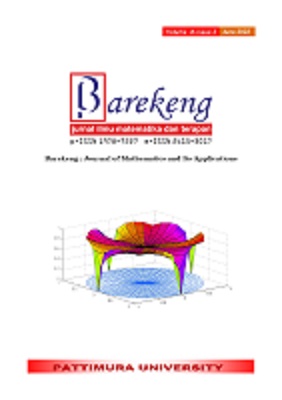CALCULATION OF CENTRAL JAVA PROVINCE REGION AREA USING SHOELACE FORMULA BASED ON THE GADM DATABASE
Abstract
This study proposes the use of the shoelace formula to determine the area of the regencies and towns/cities in the province of Central Java, which is based on the boundaries of the cities, regencies, (sub-) districts, and villages using the database from the GADM (Global Administrative Area). The results obtained are then compared with the Karney polygon method. With the shoelace formula, the area of Central Java province is 34365.40 km2 (4.77% wider than the reference area), while the Karney polygon method yields 34379.48 km2 (4.81% wider than the reference area). The area calculated using the boundaries of sub-districts is closer to the reference area if compared to using the boundaries of the regencies/cities and of villages. MdAPE values of 6.46 % and 6.54 % are obtained using the shoelace formula and the Karney polygon method respectively.
Downloads
References
A. Setiawan and E. Sediyono, “The Use of Google Maps and Universal Transverse Mercator (UTM) Coordinate in Land Measurement of Region in Different Zone,” Journal of Theoretical and Applied Information Technology, vol. 96, no. 23, pp. 8071–8080, 2018.
A. Setiawan and E. Sediyono, “A New Determination of Regional Area by Utilizing Rectangular Approach Method and Google Maps,” in 2017 2nd International Conferences on Information Technology, Information Systems and Electrical Engineering (ICITISEE), 2017, pp. 417–420.
A. Setiawan and E. Sediyono, “Using Google Maps and Spherical Quadrilateral Approach Method for Land Area Measurement,” in 2017 International Conference on Computer, Control, Informatics and its Applications: Emerging Trends In Computational Science and Engineering (IC3INA), 2017, pp. 85–88.
C. F. F. Karney, “Algorithms for Geodesics,” Journal of Geodesy, vol. 87, no. 1, pp. 43–55, 2012.
C. F. F. Karney, “GeographicLib 1.49,” 2017. https://geographiclib.sourceforge.io/1.49/ (accessed Feb. 22, 2022).
GADM, “GADM maps and data,” 2021. https://gadm.org/ (accessed Feb. 22, 2022).
Y. Lee and W. Lim, “Connecting the Area of a Polygon and the Vector Cross Product,” The Mathematics Teacher, vol. 110, no. 8, pp. 631–636, 2017.
Y. Lee and W. Lim, “Shoelace Formula: Connecting the Area of a Polygon and the Vector Cross Product,” The Mathematics Teacher, vol. 110, no. 8, pp. 631–636, 2017.
K. R. Wijeweera and S. R. Kodituwakku, “A Simple Algorithm for Calculating The Area of an Arbitrary Polygon,” Ruhuna Journal of Science, vol. 8, pp. 67–75, 2017.
J. P. Snyder, “Map Projections - A Working Manual,” 1987.
K. KAWASE, “Concise Derivation of Extensive Coordinate Conversion Formulae in the Gauss-Krüger Projection,” Bulletin of the Geospatial Information Authority of Japan, vol. 60, 2013.
Bidang Integrasi Pengolahan dan Diseminasi Statistik, Provinsi Jawa Tengah dalam Angka 2021. Badan Pusat Statistik Provinsi Jawa Tengah, 2021.
Tarek M. Awwad, “Relationship of ETM and UTM Projection Scale Factors in Egypt,” International Journal of Civil Engineering (IJCE), vol. 5, no. 6, pp. 57–68, 2016.
P. Pędzich and M. Kuźma, “Application of Methods for Area Calculation of Geodesic Polygons on Polish Administrative Units,” Geodesy and Cartography, vol. 61, no. 2, pp. 105–115, 2012.
S. Z. Bolbol, K. M. Zaky, and A. A. Ghonem, “Non Iterative Formulae for Direct Geodetic Problem,” Australian Journal of Basic and Applied Sciences, vol. 12, no. 9, pp. 131–134, 2018.
Y. Lumban-Gaol, A. N. Safi’i, P. Hartanto, and T. R. N. Rachma, “Analysis on the Effect of Map Projection System for Area Calculation,” IPTEK Journal of Proceedings Series, no. 2, pp. 69–72, 2019.
D. Kin and Y. Karpinskyi, “Ontology of Geodetic, Cartometric and Morphometric Methods in The Geoinformation Environment,” 2021.
F. Yildirim and F. Kadi, “Determining The Area Corrections Affecting The Map Areas in GIS Applications,” Reports on Geodesy and Geoinformatics, vol. 112, pp. 9–17, 2021.
S. N. Kundu and B. Pradhan, “Surface Area Processing in GIS,” 2004.
I. A. of O. & G. P. (OGP), “OGP Surveying and Positioning Guidance Note number,” 7, 2009.
J. Dozier, Improved Algorithm for Calculation of UTM and Geodetic Coordinates. National Oceanic and Atmospheric Administration, 1980.
Authors who publish with this Journal agree to the following terms:
- Author retain copyright and grant the journal right of first publication with the work simultaneously licensed under a creative commons attribution license that allow others to share the work within an acknowledgement of the work’s authorship and initial publication of this journal.
- Authors are able to enter into separate, additional contractual arrangement for the non-exclusive distribution of the journal’s published version of the work (e.g. acknowledgement of its initial publication in this journal).
- Authors are permitted and encouraged to post their work online (e.g. in institutional repositories or on their websites) prior to and during the submission process, as it can lead to productive exchanges, as well as earlier and greater citation of published works.






1.gif)



